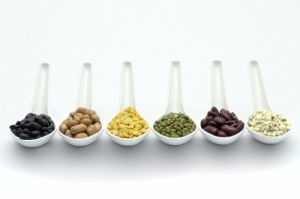My iron levels were fine, but the truth behind dietary iron is surprising. While my doctor was concerned about anemia, it turns out that iron overload is now becoming more common in the United States than iron deficiency.
Non-heme iron better than heme iron
There are two types of iron: heme iron that is only found in meat and non-heme iron that is the only kind found in plants.
Heme iron is found in shellfish, red meat, poultry, and fish with the darkest meats containing the most iron. It is the most readily absorbed form of iron and you generally absorb between 15% to 35% of the heme iron you consume. However its uptake is unregulated – so consuming too much meat, especially red meat, can eventually lead to iron overload.
Non heme iron, is the only form of iron found in plants, but is also present in eggs, milk and meat. It is less easily absorbed with only 2% to 20% being absorbed. Unlike heme iron its uptake is regulated; your body will only use the iron it needs. So a vegan diet avoids the risk of iron overload.
Iron deficiency is no more common in vegans than in the normal population presumably because typical vegan foods contain high amounts of non-heme iron.
Too much iron is bad for you
Too much iron creates free radicals which in turn wreak havoc within your body. Elevated iron stores have been associated with many diseases including inflammation, arthritis, diabetes, gall stones, cancer and heart disease.
Your stores of iron accumulate with the absorption of dietary iron, but your body has no mechanism for excreting excess iron. Although regular loss of blood though blood donation or menstruation can offer some protection against iron overload.
Studies have shown an almost linear increase of iron stores with age in men eating a typical diet. Iron stores in vegans tend to be lower, lowering their risk of disease without making them any more prone to deficiency.
Another risk to consider is that one in every two hundred people have the genetic mutation for hereditary hemochromatosis – this often undiagnosed condition results in two to three times as much dietary iron being absorbed than normal.
Making the most of your iron
Foods such as beans and greens contain plenty of safe non-heme iron whereas supplements contain potentially dangerous heme iron. So to meet your iron needs I would recommend eating plenty of iron rich plant foods and avoiding supplements containing iron unless you are undergoing treatment for a diagnosed iron deficiency.
Some foods containing phytates (whole grains, legumes, nuts and seeds), polyphenols (coffee, tea, red wine) and calcium supplements can inhibit non-heme iron absorption. However vitamin C (plentiful in greens and fruit) can increase iron absorption by as much as 30%.
You need to replace 0.9 mg per day of iron lost through bodily processes . Menstruating females need to replace an additional 0.4 mg per day. Pregnancy or lactation requires an additional 4 mg per day.
Recommended Daily Intake
Given the range of absorption levels, the daily recommended intake may not be very accurate for you personally. The recommendations are 1.8 times higher for vegans and vegetarians. However, as is often the case with these kinds of recommendations, a worst case diet (biased towards inhibitors) was assumed.
Institute of Medicine Iron RDI (omnivore/vegetarian):
- Men and post-menopausal women (8mg/14.4mg)
- Menstruating Females (18mg/32.5mg)
- Breastfeeding (9mg/16.2mg)
- Pregnancy (27mg/48.6mg)
Generally if you are eating a healthy vegan diet you will be getting plenty of non-heme iron.
You can optimize your intake by:
- Eating lots of iron rich plant foods such as legumes and greens
- Avoiding tea, coffee and calcium supplements during meals
- Including vitamin C rich foods such as greens and fruit in your meals


Thanks for this post! I have been looking for info on heme and non-heme iron!
Wonderful blog! I found it while surfing around on
Yahoo News. Do you have any suggestions on how to get listed in Yahoo News?
I’ve been trying for a while but I never seem to get there! Thank you